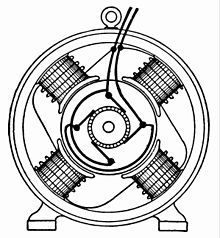- Field coil
-
A field coil is a component of an electro-magnetic machine, typically a rotating electrical machine such as a motor or generator. A current-carrying coil is used to generate a magnetic field.
Magnetic fields require a continuous circuit, thus more than one pole. Most arrangements use one field coil per pole. Some older or simpler arrangements use a single field coil with a pole at each end.
Although field coils are most commonly found in rotating machines, they are also used, although not always with the same terminology, in many other electromagnetic machines. These include simple electromagnets through to complex lab instruments such as mass spectrometers and NMR machines.
Contents
Fixed and rotating fields
Most[note 1] DC field coils generate a constant, static field. Most three-phase AC field coils are used to generate a rotating field as part of an electric motor. Single-phase AC motors may follow either of these patterns: small motors are usually universal motors, like the brushed DC motor with a commutator, but run from AC. Larger AC motors are generally induction motors, whether these are three- or single-phase.
Stators and rotors
Many[note 1] rotary electrical machines require current to be conveyed to (or extracted from) a moving rotor, usually by means of brushgear. This brushgear is often the most complex and least reliable part of such a machine. It may also represent a limit on the maximum current that the machine can handle. For this reason, when machines must use two sets of windings, the windings carrying the least current are usually placed on the rotor and those with the highest current on the stator.
The field coils can be mounted on either the rotor or the stator, depending on whichever method is the most cost-effective for the device design.
For electric motors, the field is mounted on the stator. In a brushed DC motor the field is static but the armature current must be commutated, so as to continually rotate. This is done by supplying the armature windings on the rotor through a commutator, a combination of rotating slip ring and switches. AC induction motors also use field coils on the stator, the current on the rotor being supplied by induction in a squirrel cage.
For generators, the field current is smaller than the output current.[note 2] Accordingly the field is mounted on the rotor and suppplied through slip rings. The output current is taken from the stator, avoiding the need for high-current sliprings. In DC generators, which are now generally obsolete in favour of AC generators with rectifiers, the need for commutation meant that brushgear and commutators could still be required. For the high-current, low-voltage generators used in electroplating, this could require particularly large and complex brushgear.
Bipolar and multipolar fields
In the early years of generator development, the stator field went through an evolutionary improvement from a single bipolar field to a later multipole design.
Bipolar generators were universal prior to 1890 but in the years following it was replaced by the multipolar field magnets. Bipolar generators were then only made in very small sizes.[1]
The stepping stone between these two major types was the consequent-pole bipolar generator, with two field coils arranged in a ring around the stator.
This change was needed because higher voltages allow current to flow greater distances over small wires. To increase the output voltage, a DC generator must be spun faster, but beyond a certain speed this is impractical for very large power transmission generators.
By increasing the number of pole faces surrounding the Gramme ring, the ring can be made to cut across more magnetic lines of force in one revolution than a basic two-pole generator. Consequently a four-pole generator could output twice the voltage of a two-pole generator, a six-pole generator could output three times the voltage of a two-pole, and so forth. This allows output voltage to increase without also increasing the rotational rate.
In a multipolar generator, the armature and field magnets are surrounded by a circular frame or "ring yoke" to which the field magnets are attached. This has the advantages of strength, simplicity, symmetrical appearance, and minimum magnetic leakage, since the pole pieces have the least possible surface and the path of the magnetic flux is shorter than in a two-pole design [1]
Winding materials
Coils are typically wound with enamelled copper wire, sometimes termed magnet wire. The winding material must have a low resistance, to reduce the power consumed by the field coil, but more importantly to reduce the waste heat produced by ohmic heating. Excess heat in the windings is a common cause of failure. Owing to the increasing cost of copper, aluminium windings are increasingly used.
An even better material than copper, except for its high cost, would be silver as this has even lower resistivity. Silver has been used in rare cases. During World War II the Manhattan project to build the first atomic bomb used electromagnetic devices known as calutrons to enrich uranium. Thousands of tons of silver were borrowed from the U.S. Treasury reserves to build highly-efficient low-resistance field coils for their magnets.[2][3]
See also
References
- ^ a b Field coils are found in a vast array of electrical machines and so any attempt to categorise them in a readable manner is likely to exclude some obscure examples.
- ^ Strictly it is the output power that is greater than the field power, although in practice this usually implies that the current is greater too.
- ^ a b Hawkins Electrical Guide, Volume 1, Copyright 1917, Theo. Audel & Co., Chapter 14, Classes of Dynamo, page 182
- ^ "The Silver Lining of the Calutrons". ORNL Review (Oak Ridge National Lab). 2002. http://www.ornl.gov/info/ornlreview/rev25-34/chapter1sidebar6.htm.
- ^ Smith, D. Ray (2006). "Miller, key to obtaining 14,700 tons of silver Manhattan Project". Oak Ridger. Archived from the original on 2007-12-17. http://web.archive.org/web/20071217171643/http://www.oakridger.com/stories/051606/opi_20060516028.shtml.
Categories:- Electricity
- Electromagnets
- Electromagnetism
- Electrical machines
Wikimedia Foundation. 2010.




